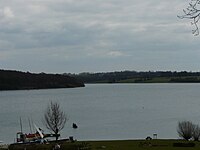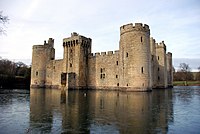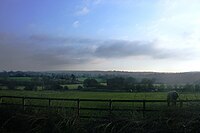Sussex Border Path
| Sussex Border Path | |
|---|---|
The Sussex Border Path is a long-distance footpath around the borders of Sussex, a historic county and former medieval kingdom in southern England. The main path is 150 miles (240 km) long and stays close to Sussex's borders with Hampshire, Surrey and Kent, connecting Thorney Island (50°49′16″N 0°55′16″W / 50.821°N 0.921°W) to Rye (50°56′56″N 0°43′44″E / 50.949°N 0.729°E).[1] There is also an additional 33-mile (53 km) spur known as the Mid Sussex Link, which links East Grinstead with Fishersgate and Mile Oak on the western boundary of the city of Brighton and Hove.[2]
The Sussex Border Path is not a
History
The path was first devised and published in 1983 by Ben Perkins and Aeneas Macintosh.
Sussex's external boundaries probably crystallised around the 6th and 7th centuries.
In 1974 the area of Sussex was divided into two
Route
The Sussex Border Path begins at Thorney Island, now effectively a peninsula that juts into Chichester Harbour.[citation needed] The path forms a 9-mile (14 km) circuit around the island;[1] it then extends across the South Coast Plain to Emsworth on the Hampshire side of the River Ems, the river which forms the Sussex-Hampshire border at this location. The path continues over the chalk ridge of the South Downs and onto the Greensand Ridge of the western Weald. Here the trail ascends Blackdown, the highest point in Sussex at 280 metres (920 ft) and the highest point on the Sussex Border Path.
From Blackdown, the path continues into the Low Weald to Gatwick Airport and into the High Weald to the town of East Grinstead. From here the path descends to the Romney marshes to end in the historic town of Rye.
The Mid Sussex Link begins at East Grinstead and passes through Sharpthorne and Scaynes Hill to Ditchling, then over the South Downs to Fishersgate, between Southwick and Portslade.[2]
Image gallery
-
Great Deep separates Thorney Island from the mainland
-
Farmland near Rogate
-
Near Blackdown
-
The Gatwick Stream near Gatwick Airport
-
Near Crawley Down
-
The town of Rye marks the eastern terminus of the Sussex Border Path
-
A section of the Mid Sussex Link shared with theformer railway line between East Grinstead and Groombridge
See also
- South Downs Way
- The Four Men: a Farrago
References
- ^ a b c "Sussex Border Path". West Sussex County Council. Retrieved 2 April 2021.
- ^ LDWA. Retrieved 2 April 2021.
- ^ "Sussex Border Path". Sussex Ramblers. Retrieved 27 September 2019.
- ^ Thomas, Gabor (January 2013). "Resource Assessment and Research Agenda for the Anglo-Saxon period" (PDF) (PDF). South East Research Framework.
- ISBN 9780415242110.
- ^ "Eric Pickles: celebrate St George and England's traditional counties". Department for Communities and Local Government. 23 April 2013. Retrieved 22 June 2013.
- ^ Kelner, Simon (23 April 2013). "Eric Pickles's championing of traditional English counties is something we can all get behind". The Independent. London. Archived from the original on 25 May 2022. Retrieved 22 June 2013.










